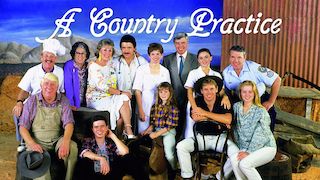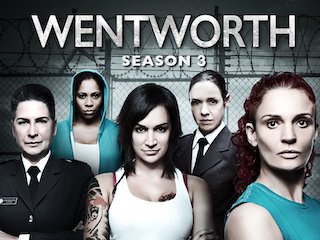Have you ever scoffed at an Aussie television drama? Have you complained that our dramas are aimed at the lowest common denominator; that anyone could write the senseless drivel that clogs the ducts of primetime TV?
Here is your chance to prove your theories. Below is a step-by-step guide to devising your own Aussie TV drama.
To begin, find a quiet table in a trendy cafe. Get a coffee and settle in. This won’t take long. Pen ready?
Before you run, prove you can walk. Warm up by writing some “moronic waffle for the masses”. Piece of cake.
Let’s get started
Let’s create a typical Aussie TV drama comprised of 22 one-hour episodes. We’ll call it Farmers and Nurses.
The show can be about a bunch of cow cockies cracking on to the horny (yet demure) nurses from the local country hospital. They must all deal with crises on the land, affairs of the heart and remedies for groin injuries.
The key themes are high romance, life and death struggles and down-in-the-dirt yakka. Sound dumb enough?
Every producer knows that even mind-numbing garbage requires careful planning. Here are the guidelines..
The cast should have six major characters. Typically, there are eight or more secondary characters. These can all be devised on the back of a napkin between macchiatos and chapters of Anna Karenina.
To keep things interesting, no character should be entirely saintly or utterly devilish. They must reflect humanity in its complexity. We love “good guys” more if we can see their flaws. And Darth Vader’s wickedness was made more compelling because he was a nice bloke deep down, remember?
Devise each major character‘s fears, hopes, strengths and weaknesses. Don’t repeat these qualities. Everyone must be different. The qualities may be familiar (greed, insecurity, open-heartedness) but they must be balanced in original ways that create inner tension. For example, the first farmer hopes to build a Big Cow outside the town but is sensitive to criticism; the second loves solitude but fears dying alone; the third is horny but demure.
Discover where these qualities overlap or conflict. Repeat the process for the secondary characters. Repeat again for the entire cast. Order another macchiato. And more napkins.
Your first episode
To construct your first episode, whatever you do, don’t start with the first episode! The introduction of the characters and establishment of the setting add troublesome layers of complexity to the act of compelling story-telling.
Begin with episode three so your romances, rivalries and underlying sexual tensions are up and running (see napkin #1).
But not yet. First devise the “character arcs”. Like Noah, everyone in the series has to begin somewhere (wet) and end up somewhere else (dry).
Things work best when each character goes from one general psychological and emotional state to another, deal with one and a set of stakes and then another higher set of stakes. Because you have time before the cake arrives, alter or threaten the status of each character.
Each character will require a “series arc” – a journey of discovery, loss or reward that begins in episode one and ends in episode 22. They’ll each need 22 “episode arcs”, one for each week. For an entire series, that will mean 132 major character episode arcs.
Some minor characters won’t require series arcs. The “bloke who runs the pub” doesn’t change much. He’s there as a bouncing board for our stars. But let’s be clever and devise 176 secondary character episode arcs anyway. (Remember, every character in every scene and sequence of scenes needs their own arc for each scene and sequence.)
At this stage, it may be simpler to begin scribbling on the tablecloth.
Writing your script
Now you can begin writing your script. The first step is not to write the script. A storyline and storyline-outline are needed. Storylines are typically or two tablecloths long. They briefly detail each scene and the overall events, arcs and themes of the episode.
Your six characters should all have stories.
Each episode should comprise one major story (the A-story) and two to four minor stories (B-stories). Ideally, each story should help resolve the stories of other characters. For example, episode three’s A-story is about John’s need to get rid of his un-milkable cow. The B-story is about Janette’s desire for a pet to love.
After various unsuccessful attempts, John finally gives Janette his cow. Janette is initially grateful but then realises it is not a pet she wants – she wants John.
For cohesiveness, the other four major characters should be in the mix. Maybe Bazza wants a non-milking cow to guard his chickens but is too proud to ask. When Janette declines the cow in favour of John, Bazza overcomes his pride and asks for the cow. Whereupon, Janette decides to accept the cow for the sake of endearing herself to John. And so on.
(It’s better if the cow does not become a major character. Cows don’t respond to direction and tend to stare at the camera. Besides, if the series has big name actors, there will be enough cows in the cast already.)
A typical cud-chewing episode of Aussie drama will have between 20 and 40 scenes. Unfortunately, that means another 20 to 240 scene arcs, depending on the number of people in each scene.
Scene arcs are essential but, as you’re only creating a mindless piece of crap for the lowest commoners out there, you can keep the arcs simple. (Just be sure they overlap neatly, contain unexpected twists that conform with the characters’ natures and build to a satisfying resolution or cliffhanger.)
At this stage, you’d better order something to eat or the waiters will start throwing you daggers.
Serve the story
Using the storyline as a guide, the actual script is the easy bit. Dialogue is a piece of cake. Keep it minimal. If it doesn’t serve the story, cut it. Where possible, characters should express their thoughts and emotions with action, not words, show not tell. (This technique is probably employed for the shallow masses who can’t grasp conversations of any depth or length, particularly about cows. Though, oddly, Stanley Kubrik and Francois Truffaut also believed in the principle.)
Keep each scene to two pages or less to keep things snappy. Give all the A- and B- stories three acts (Problem, Complications, Resolution) and resolve them in original and surprising ways. Above all, keep it simple.
Make the script accessible. Make the characters lovable, or at least understandable and endurable. Leave no loose ends. Evoke emotions in the viewer. Where possible, provoke thoughts (even if they are obvious, cheesy, Epsilon thoughts).
You have six segments and 42 minutes of airtime to tie it all off in a neat little bow. Things are more flexible on cable or streaming, but you’re travelling the easy path first, yes?
Bottom line: the viewers must enjoy it enough to watch again next week.
That is the “formula”. If you complete a script before lunch, grab the tablecloth and run straight to the nearest drama executive.
If not, shut up, go home, switch on the telly and enjoy the show.
Hopefully, those who moan at Aussie TV dramas may now have an inkling of the complexities involved in creating simple, appealing stories.
Even the blandest drama episode is the result of months of work by clever people. Australian drama writers strive hard to create stories and characters that do all of the above. They have hits and misses. They should be forgiven for both.
That is, unless you can do better.


